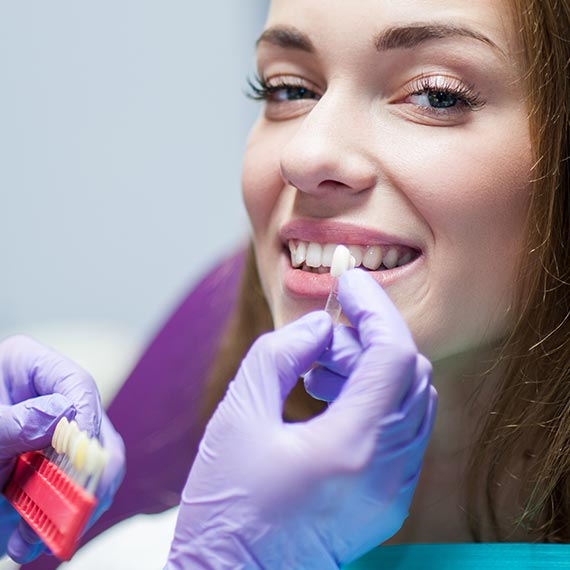Crowns
A crown is a custom-made artificial cap that covers the remains of a natural tooth. Dental crowns are used to strengthen and improve the appearance of your teeth. Book a crown consultation with us at Victoria Road Dental Practice in Exmouth.
Why would I need a dental crown?
Your dentist may advise you to have a dental crown fitted to:
- Improve the appearance of your tooth
- Cover a damaged or decayed tooth
- Strengthen a weak tooth
- Protect a tooth after root canal therapy
- Hold a dental bridge in place
The most common reason people have a dental crown fitted is because they have tooth decay. A crown can save your tooth so you don’t have to have it removed.
How are dental crowns fitted?
There are four steps in the process to fit a crown:
Step one: Consultation
Before you decide to have a crown fitted your dentist will explain the process to you and answer any questions you have.
They will then examine your teeth to make sure they are healthy enough to have a crown fitted. This may include an x-ray so the dentist can see the underlying health of your teeth. If you have any decay or broken fillings these will also have to be treated before you can go ahead.
Step two: Preparation
The dentist will need to change the shape of your teeth so they can hold a crown securely in place. Before they do this they’ll give you an anaesthetic to numb the area around each tooth they’re treating.
Next, they’ll take an impression of your teeth to provide a precise outline for the custom-made crown and ensure it’s matched to the exact colour of your natural teeth.
We have invested in the latest technology which allows your dentist to take an accurate digital scan of your teeth. Unlike the traditional impressions which can sometimes be unpleasant and messy, the digital scan is fuss-free.
This scan is then sent to a specialist dental laboratory which will make your crown. Your dentist will fit a temporary crown for you to wear until the new, permanent one is ready. While you’re wearing the temporary crown you should avoid chewy or sticky foods as they may loosen it.
Step three: Crown fitting
As soon as the dentist has received your new crown they’ll contact you to make an appointment to have it fitted.
Before the dentist fits the new crown they may offer you an anaesthetic to numb the area.
They will then remove the temporary crown and thoroughly clean your tooth.
Before fixing the new crown in place the dentist will make sure that it’s a perfect fit. They’ll align it with the rest of your teeth and check your bite.
Once they’re satisfied the crown is a perfect fit they’ll use dental cement to fix it in place on top of your natural tooth.
Step four: Recovery
For the first few days after having your crown fitted you should again avoid chewy or sticky foods.
Types of dental crown
There are three types of dental crown:
All-metal – these are made entirely from precious or non-precious metals.
All-ceramic – these are made from dental ceramics or porcelain and give the most lifelike finish.
Porcelain-fused-to-metal – the interior of these crowns is metal and the exterior is porcelain. Over time, if your gums recede, you may start to see a dark line, which is the metal edge, at the bottom of the crown.
Book your crown consultation online here or call us on 01395 272 018.




